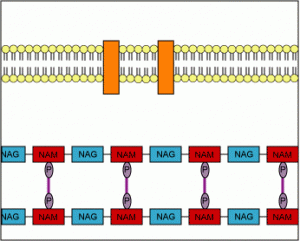DNA arrays have been given a number of different nomenclature such as DNA microarray, gene chip, or even biochip. The lifecycle of a cell is dynamic process in which gene expression is turned on or off at different points in order to trigger events in the cell cycle or even to combat changes in the external environment of the cell. The basic principle of DNA arrays or microarrays is to analyze the patterns of gene expression within a cell at different time points in the life cycle of the cell. The DNA microarray was developed on the core principle of hybridization of between two DNA strands. That is to say that two strands of DNA with complimentary sequences would form hydrogen bonds together to form the double helical structure. The method generally consists of a glass slide onto which different DNA sequences are attached. The sample of DNA obtained from the cells is then put onto this slide to allow the hybridization process to occur. This is followed by washing off the unbound DNA. After this, the slide is observed using fluorescence or other labeling techniques. To better understand this procedure do check out the animation below. See also animation of GeneChips.
The animation was provided by the DNA Learning Center and their YouTube Channel. “The mission of the DNA Learning Center is to prepare students and families to thrive in the gene age.”
Animation
[swfobject]1463[/swfobject]
Transcript
In the 1990s, the DNA arrays provided the means to analyze patterns of gene expression at different timepoints in a living cell. DNA microarrays often consist of glass slides with spots of attached DNA fragments. The DNA fragments act as probes for specific sequences in a sample.
Pat Brown developed a technique where cDNAs can be embedded onto glass slides. Using these arrays, he could do large-scale expression studies.
Growth stage-specific mRNAs are isolated, and then reverse transcribed to give unique cDNA populations. These are directly embedded onto specially coated glass slides.
The slides are coated with poly-lysine, which is positively charged. DNA is negatively charged, so the cDNA “sticks” to the slide through an ionic interaction. The cDNA can still interact with a DNA probe.
Brown used arrays to obtain gene expression profiles of cancer. Diffuse large B-cell lymphoma (DLBCL) is a common lymphoma- cancer of the lymph nodes. He found sub-types of DLBCL that correlated with survival rates.
Brown made a chip with genes expressed by the lymph nodes and those important in cancer biology. A total of 17,856 cDNA genes were printed onto what we called “lymphochip.” Remember, each square on the chip corresponds to a different cDNA.
Then he made cDNAs from different DLBCL tumors.
He labelled one set of cDNA with a red fluorescent tag; the other with a green tag.
Brown incubated the arrays with the tagged cDNAs, which bound to the matching genes printed on the array.
Since he knew the positions of the genes on the DNA array, Brown could figure out the levels of gene expression based on the color signal. If the gene was only expressed in DLBCL1 cells, the square was red. Similarly, if the gene was only expressed in DLBCL2 cells, the square was green. If the gene was expressed equally in both cells, the square was yellow.
Thus, Brown identified two sub-types of DLBCL-GC B-like and Activated B-like DLBCL. These sun types have different responses to therapy, and with this type of diagnosis, more tailored treatment can begin for patients. This type of tailored treatment is called “pharmacogenomics.”
Brown can also analyse the differences in gene expression for these two very similar lymphomas. This may give a better understanding of how cancers work, and hopefully develop better therapies and cures.

